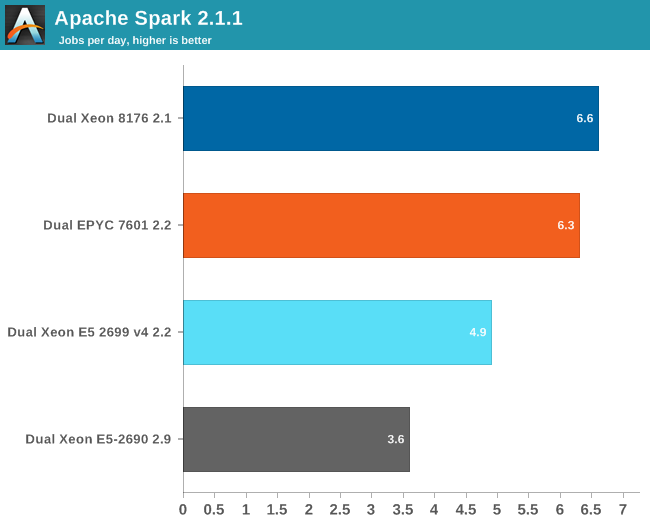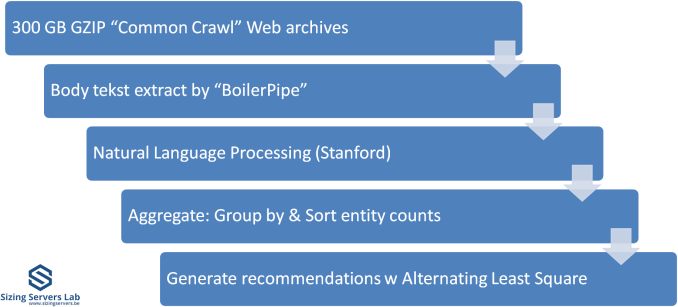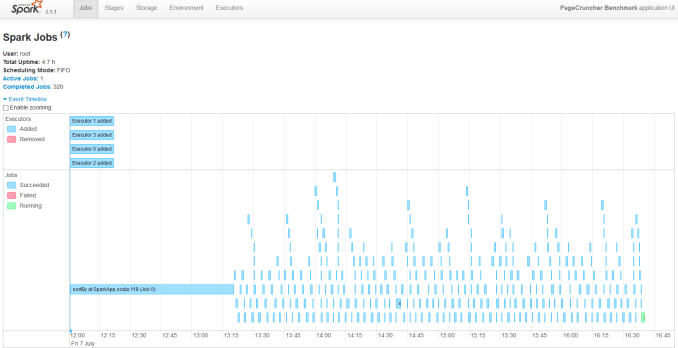Sizing Up Servers: Intel's Skylake-SP Xeon versus AMD's EPYC 7000 - The Server CPU Battle of the Decade?
by Johan De Gelas & Ian Cutress on July 11, 2017 12:15 PM EST- Posted in
- CPUs
- AMD
- Intel
- Xeon
- Enterprise
- Skylake
- Zen
- Naples
- Skylake-SP
- EPYC
Apache Spark 2.1 Benchmarking
Apache Spark is the poster child of Big Data processing. Speeding up Big Data applications is the top priority project at the university lab I work for (Sizing Servers Lab of the University College of West-Flanders), so we produced a benchmark that uses many of the Spark features and is based upon real world usage.
The test is described in the graph above. We first start with 300 GB of compressed data gathered from the CommonCrawl. These compressed files are a large amount of web archives. We decompress the data on the fly to avoid a long wait that is mostly storage related. We then extract the meaningful text data out of the archives by using the Java library "BoilerPipe". Using the Stanford CoreNLP Natural Language Processing Toolkit, we extract entities ("words that mean something") out of the text, and then count which URLs have the highest occurrence of these entities. The Alternating Least Square algorithm is then used to recommend which URLs are the most interesting for a certain subject.
In previous articles, we tested with Spark 1.5 in standalone mode (non-clustered). That worked out well enough, but we saw diminishing returns as core counts went up. In hindsight, just dumping 300 GB of compressed data in one JVM was not optimal for 30+ core systems. The high core counts of the Xeon 8176 and EPYC 7601 caused serious performance issues when we first continued to test this way. The 64 core EPYC 7601 performed like a 16-core Xeon, the Skylake-SP system with 56 cores was hardly better than a 24-core Xeon E5 v4.
So we decided to turn our newest servers into virtual clusters. Our first attempt is to run with 4 executors. Researcher Esli Heyvaert also upgraded our Spark benchmark so it could run on the latest and greatest version: Apache Spark 2.1.1.
Here are the results:

If you wonder who needs such server behemoths besides the people who virtualize a few dozen virtual machines, the answer is Big Data. Big Data crunching has an unsatisfiable hunger for – mostly integer – processing power. Even on our fastest machine, this test needs about 4 hours to finish. It is nothing less than a killer app.
Our Spark benchmark needs about 120 GB of RAM to run. The time spent on storage I/O is negligible. Data processing is very parallel, but the shuffle phases require a lot of memory interaction. The ALS phase does not scale well over many threads, but is less than 4% of the total testing time.
Given the higher clockspeed in lightly threaded and single threaded parts, the faster shuffle phase probably gives the Intel chip an edge of only about 5%.












219 Comments
View All Comments
msroadkill612 - Wednesday, July 12, 2017 - link
It looks interesting. Do u have a point?Are you saying they have a place in this epyc debate? using cheaper ddr3 ram on epyc?
yuhong - Friday, July 14, 2017 - link
"We were told from Intel that ‘only 0.5% of the market actually uses those quad ranked and LR DRAMs’, "intelemployee2012 - Wednesday, July 12, 2017 - link
what kind of a forum and website is this? we can't delete the account, cannot edit a comment for fixing typos, cannot edit username, cannot contact an admin if we need to report something. Will never use these websites from now on.Ryan Smith - Wednesday, July 12, 2017 - link
"what kind of a forum and website is this?"The basic kind. It's not meant to be a replacement for forums, but rather a way to comment on the article. Deleting/editing comments is specifically not supported to prevent people from pulling Reddit-style shenanigans. The idea is that you post once, and you post something meaningful.
As for any other issues you may have, you are welcome to contact me directly.
Ranger1065 - Thursday, July 13, 2017 - link
That's a relief :)iwod - Wednesday, July 12, 2017 - link
I cant believe what i just read. While I knew Zen was good for Desktop, i expected the battle to be in Intel's flavour on the Server since Intel has years to tune and work on those workload. But instead, we have a much CHEAPER AMD CPU that perform Better / Same or Slightly worst in several cases, using much LOWER Energy during workload, while using a not as advance 14nm node compared to Intel!And NO words on stability problems from running these test on AMD. This is like Athlon 64 all over again!
pSupaNova - Wednesday, July 12, 2017 - link
Yes it is.But this time much worse for Intel with their manufacturing lead shrinking along with their workforce.
Shankar1962 - Wednesday, July 12, 2017 - link
Competition has spoiled the naming convention Intels 14 === competetions 7 or 10Intel publicly challenged everyone to revisit the metrics and no one responded
Can we discuss the yield density and scaling metrics? Intel used to maintain 2year lead now grew that to 3-4year lead
Because its vertically integrated company it looks like Intel vs rest of the world and yet their revenue profits grow year over year
iwod - Thursday, July 13, 2017 - link
Grew to 3 - 4 years? Intel is shipping 10nm early next year in some laptop segment, TSMC is shipping 7nm Apple SoC in 200M yearly unit quantity starting next September.If anything the gap from 2 - 3 years is now shrink to 1 to 1.5 year.
Shankar1962 - Thursday, July 13, 2017 - link
Yeah 1-1.5 years if we cheat the metrics when comparison2-3years if we look at metrics accurately
A process node shrink is compared by metrics like yield cost scaling density etc
7nm 10nm etc is just a name